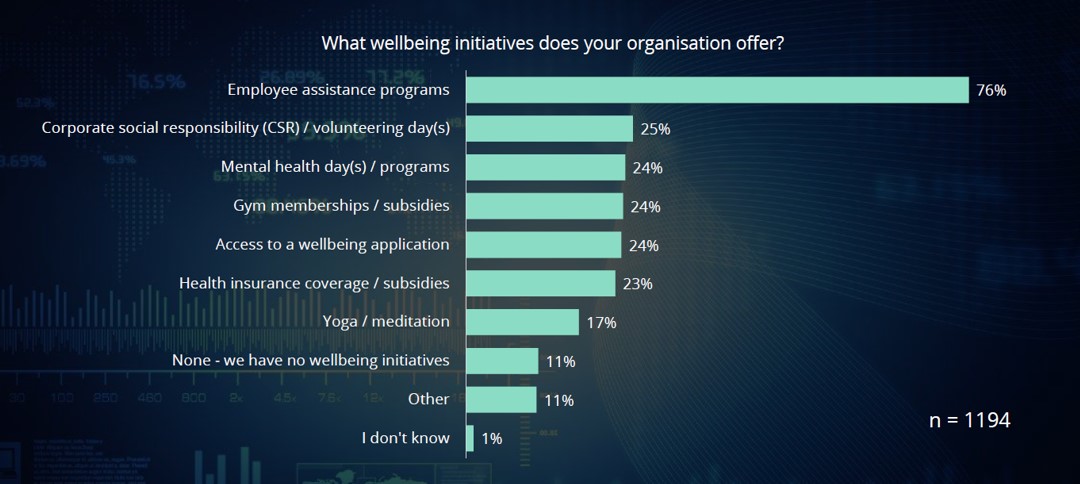Employee Wellbeing in a Hybrid Working Environment

Before the pandemic, leadership/manager training traditionally focused on the management of office-based/onsite employees. Lessons on leading a hybrid workforce – that is, a blend of in-office and remote working – were not typically on the training agenda.
Yet, as the adoption of the hybrid model becomes more widespread, managers the world-over are learning as they go. It has become clear that leading a hybrid team requires a different leadership style and involves new considerations and challenges – challenges that have been exacerbated by COVID-19.
Read: Building the Employee Experience (EX) for a Hybrid Work Model
One such challenge is preserving employee health and wellbeing. According to ELMO’s 2021 HR Industry Benchmark Report, which is based on a survey of more than 1800 HR professionals in Australia and New Zealand, 87% percent of organisations consider employee wellness to be a high or medium priority since the outbreak of COVID-19.
Preserving employee health and wellbeing within a hybrid setting is new territory for many employers. Below are 5 tips for ensuring employee wellbeing is a priority.
1. Know how to recognise poor wellbeing
Within in hybrid working environment, it’s important that managers are clued up on recognising when an employee’s mental health is declining. Of course, this is trickier when team members are dispersed or working remotely, but there are some key signs to look out for:
Change in mood or behaviour
Easily frustrated, irritated or angered
Withdrawal from social interactions
Increased time off work
Lack of motivation or focus
Decline in productivity
Recurring out-of-character mistakes
Tiredness and anxiousness
Unkempt/unhealthy appearance
If an employee is displaying any of the above signs, it could be an indication that their health and wellbeing is suffering, and that they require additional assistance and support – whether that be through access to an employee assistance program (EAP) or through regular check-ins with their manager or HR to determine what the organisation can do to help.
2. Enhance employee listening channels
Ensuring employees’ needs and experiences are being heard is critical in any working environment. However, being attuned to employees’ needs is more difficult in a hybrid setting because workforces are often dispersed, and employees may have less in-person facetime with their managers or peers.
To remedy this, employers should conduct regular employee pulse surveys in order to gauge overall sentiment, engagement, sense of belonging, and psychological and physical wellbeing. What’s more, surveying employee is empowering as it assures them their voices matter, which in turn strengthens employer-employee trust. Using survey software like ELMO Survey is a great way to gather feedback on how employees are faring day-to-day.
3. Encourage healthy work-life balance
So often managers are guilty of ‘toxic productivity’, meaning they have an unhealthy obsession with being productive and hardly ever switch off. Working over-time for extended periods is oftentimes worn as a badge of honour, but it sets a dangerous precedent. In fact, neglecting self-care results in burn-out and poor wellbeing – especially during volatile times, e.g. the pandemic.
Managers should remember to lead by example when it comes to setting boundaries around their work and scheduling downtime. For example, managers should refrain from sending emails out of hours, and must be careful when publicly praising employees who have exhibited ‘toxic productivity’ as it is not a sustainable working behaviour.
4. Facilitate communication and connectivity
When building and implementing a hybrid work model, managers may not know or have all the answers. However, honest and open communication is the foundation of a successful hybrid work model, and employers must enhance communication across both remote and onsite workers.
Ways to facilitate open communication include:
- Schedule regular team meetings and employee-manager check-ins
- Implement collaborative technology such as Zoom, Microsoft Teams and Slack
- Keep employees up to date on company-wide news via email and through leaders
- Schedule ‘light-hearted’ meetings/meetups where employees can relax and discuss non-work matters
When employees feel in the loop, they will have greater trust in their employer. And with trust comes more loyalty and commitment to their work.
5. Prioritise employee wellbeing initiatives
Since the pandemic, many organisations have increased their focus on wellbeing initiatives. As we mentioned earlier, employee wellness is a top priority for most organisations in Australia and New Zealand.
There are plenty of ways employers can support employee wellbeing in a hybrid environment. ELMO’s report provided insight into common wellbeing initiatives and found that 76% of survey respondents said their organisation offers an employee assistance program (EAP); 25% said they offer volunteering days and 24% said they offer mental health day(s) / programs. See the full results in the graph below.

Employers can also enhance wellbeing through social activities, but this can be challenging in a hybrid setting where some team members are working remotely, and others are in the office. A way around this is to ensure the office is as collaborative and social as possible, so when employees do work from the office, they can enjoy perks such as wellness and fitness sessions, coffee breaks, happy hour, and team brainstorming/work sessions. When teams are working remotely, video conferencing tools are a great way to ensure people stay connected.
Implementing a hybrid work model may be a new venture for many organisations, and there will be bumps in the road, but if employee wellbeing is at its heart, it will yield great results.
ELMO Software is a cloud-based solution that helps thousands of organisations across Australia, New Zealand and the United Kingdom to effectively manage their people, process and pay. ELMO solutions span the entire employee lifecycle from ‘hire to retire’. They can be used together or stand-alone, and are configurable according to an organisation’s unique processes and workflows. Automate and streamline your operations to reduce costs, increase efficiency and bolster productivity. For further information, contact us.
 HR Core
HR Core 









